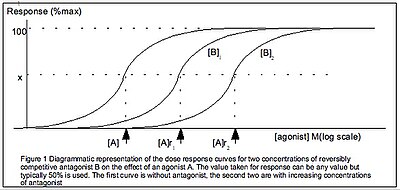EC50
Half maximal effective concentration (EC50) is a measure of the concentration of a drug, antibody or toxicant which induces a biological response halfway between the baseline and maximum after a specified exposure time.[1] More simply, EC50 can be defined as the concentration required to obtain a 50% [...] effect[2] and may be also written as [A]50.[3] It is commonly used as a measure of a drug's potency, although the use of EC50 is preferred over that of 'potency', which has been criticised for its vagueness.[3] EC50 is a measure of concentration, expressed in molar units (M), where 1 M is equivalent to 1 mol/L.
The EC50 of a graded dose response curve therefore represents the concentration of a compound where 50% of its maximal effect is observed.[4] The EC50 of a quantal dose response curve represents the concentration of a compound where 50% of the population exhibit a response,[5] after a specified exposure duration.
For clarification, a graded dose response curve shows the graded effect of the drug (y axis) over the dose of the drug (x axis) in one or an average of subjects. A quantal dose response curve shows the percentage of subjects where a response is noted in an all-or-none manner (y axis) over the dose of the drug (x axis).
For competition binding assays and functional antagonist assays IC50 is the most common summary measure of the dose-response curve. For agonist/stimulator assays the most common summary measure is the EC50.[6]
The EC50 is also related to IC50 which is a measure of a compound's inhibition (50% inhibition).
References
- ↑ Introducing dose response curves, http://www.graphpad.com/curvefit/introduction89.htm
- ↑ Chen et al.; "EC50 estimation of antioxidant activity in DPPH assay using several statistical programs" , https://www.sciencedirect.com/science/article/pii/S0308814612016020 , https://doi.org/10.1016/j.foodchem.2012.11.001
- ↑ 3.0 3.1 Neubig et al.; "International Union of Pharmacology Committee on Receptor Nomenclature and Drug Classification. XXXVIII. Update on Terms and Symbols in Quantitative Pharmacology" , https://www.guidetopharmacology.org/pdfs/termsAndSymbols.pdf , https://doi.org/10.1124/pr.55.4.4
- ↑ Northwestern Molbiosci EC50 definition, http://www.biochem.northwestern.edu/holmgren/Glossary/Definitions/Def-E/EC50.html
- ↑ Drug Dose and Clinical Response, http://www.merckvetmanual.com/mvm/index.jsp?cfile=htm%2Fbc%2F190116.htm
- ↑ Cite error: Invalid
<ref>tag; no text was provided for refs namedAssay

